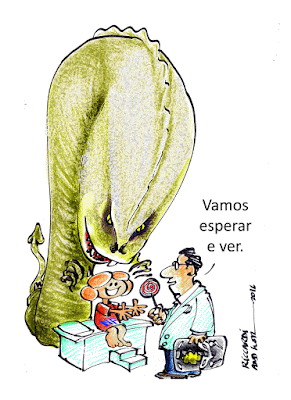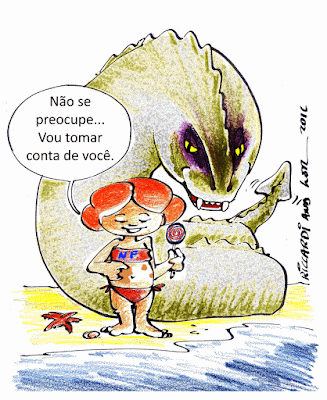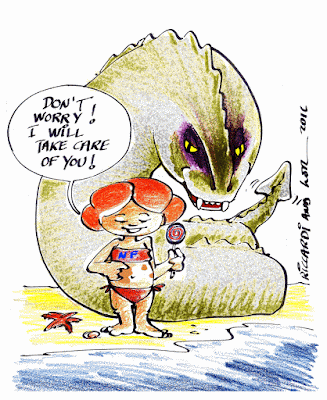Você já passou por um hidrante ou caixa de correio e imaginou que eles falaram com você? Quando isto começou a acontecer comigo achei que estava maluca. Achei que estava maluca, mas desde os seis anos não sei exatamente o que maluco significa. Mas estou com treze anos agora e sei o que significa ser maluco e que eu não era maluca na época – ou agora, de qualquer maneira. Mas você pode me achar um tanto estranha. As coisas conversam comigo.
Na maioria das vezes elas são pequenas, como uma mosca ou um grão de areia. A maior de todas foi a ponte Smithville – onde passam e passam e passam pedestres, carros, caminhões e outros veículos. E algumas vezes, como uma mosca, que fica viva, com uma boca e outras partes do corpo. E, uau, algumas vezes as coisas se tornam muito reais, partes das coisas ou do meu corpo. Isto acontece tantas vezes que eu tenho que dar nomes às coisas para poder acompanha-las. Como a Mosca Flora, ou Caixa de Correio Miguel ou Herman Hidrante. Meus pais – sempre acharam que isto é divertido ou uma brincadeira – e dão alguns nomes também. Principalmente para coisas ao redor da casa ou minhas coisas preferidas ou mesmo partes de mim. Por exemplo, Torradeira Toby, Relógio Wanda ou Ombro Suzana.
Estou falando sobre isso porque agora as coisas se compicaram um pouco mais. Quando eu estava no segundo grau, meu professor achou que eu não ia tão bem quanto podia, especialmente em aritmética. Então, eu fiz uns testes e tive que ir ver uma médica. Mas ao invés de examinar meu cérebro, a doutora ficou interessada numas quinze manchas na minha pele, parecidas com café misturado com bastante leite. Além disso, ela disse que eu era meio baixinha para a minha idade e que o número do meu chapéu era bem grande. Eu já sabia disso, porque meu boné de beisebol era tamanho sete e meio. Naquele dia, ela disse que eu tinha uma doença, algo como requinrause ou coisa assim, mas ela não sabia muito a respeito daquilo. A médica disse que era para a gente esperar e ver.
Aquela doutora se mudou e a gente esqueceu as manchas e as coisas, até que começaram as minhas menstruações. E então, voltei a outro doutor, mas desta vez ele achava que meu eu era uma garota com problema genético por causa da tal requinrause. O sujeito, Dr. Wiley, ficou todo interessado e falou um bocado. A primeira coisa que ele fez foi dar um nome para o tal do meu requinrause, NF1, e em seguida fez um longo exame em mim. Foi aí que ele encontrou uma parte da pele da barriga, perto das minhas partes íntimas. Parecia uma das manchas café com leite, mas era maior e mais alaranjada, com alguns pelos curtos nas bordas e um pouco irregular. Eu já havia notado esta diferença, mas achei que fazia parte da minha adolescência que estava começando. Ela até já havia falado comigo diversas vezes, mas eu não cheguei a dar um nome para ela.
O doutor geneticista foi quem me deu um nome para ela: Nora Fibroma. Eu estava certa de que Nora e eu nos tornaríamos amigas especiais. Eu sabia que ela seria parte importante na minha vida, como disse o Dr. Wiley, inclusive. Em seguida, ele providenciou uma ressonância magnética para ver como Nora estava dentro de mim. Depois, uma enfermeira me levou para uma sala de espera, enquanto ele discutia alguns detalhes com meus pais. Na sala de espera, eu queria que Nora conversasse comigo para que a gente pudesse se apresentar formalmente. Mas tudo o que Nora fez foi dar risadinhas.
Cerca de três semanas depois, numa Sexta Especial, fomos fazer as imagens da ressonância magnética. Apesar de eles me colocarem para dormir no equipamento de ressonância, Nora tinha um monte de coisas para dizer e eu podia ouvir claramente o que ela dizia, apesar do restante dos sons estarem totalmente bloqueados. O principal do que ela disse foi que ela coçava e que algumas partes coçavam mais do que outras. Mas, especialmente, ela estava muito impressionada como ela era grande. Não enorme, mas maior do que o esperado para a meu tamanho. Então, nós duas dormimos. Quando acordamos, o Dr. Wiley confirmou as preocupações de Nora quanto ao seu tamanho e que nós deveríamos repetir os testes um ano depois. Dr. Wiley era um cara legal, mas havia um tom diferente na sua voz, especialmente quando se referiu a Nora por diversas vezes como “tumor”. Ele me deu um pirulito e disse: “Não se preocupe! Vamos esperar e ver.”
Desde aquele momento, Nora e eu desenvolvemos uma amizade especial. Não apenas amigas, mas companheiras de verdade. O restante ia bem. A escola estava OK, apesar de eu nunca ser muito boa em esportes e aprender o tal do piano foi um verdadeiro sufoco. Enquanto isso, Nora me dizia que estava crescendo, talvez um pouco mais rapidamente do que o resto de mim. Ela também avisava que, no geral, ela estava macia e confortável, mais ou menos da mesma forma de sempre. Em paz, eram suas palavras.
Então, cerca de dois anos depois da primeira ressonância magnética, um domingo, Nora me acordou para dizer que alguma coisa tinha acontecido. Alguma coisa, numa parte muito pequena dela, havia mudado muito profundamente, próxima à linha do biquíni. Quando amanheceu, as coisas pareciam ter se acalmado. Mas, nas duas semanas seguintes ou mais, o desconforto de Nora parecia maior e pior. Ainda pequeno, mas, ah, bem diferente. Isso era totalmente novo para mim. Nenhuma das outras mensagens que que eu já havia recebido de outros objetos ou de Nora eram como esta sensação. Minha mãe tentou me tranquilizar sugerindo que tudo era parte dos meus ciclos menstruais, especialmente porque eles eram muito irregulares. Eu sentia algo na minha barriga sob a mancha café de Nora. Mais nada.
Nora continuou reclamando e era a única coisa que ela vivia falando. Coitada da Nora. Eu gostaria de poder fazer algo para ajudar.
No dia seguinte fui submetida à Tomografia com Emissão de Pósitrons (o tal PET scan) e à tal biópsia. Mais tarde, naquele mesmo dia, primeiro nos disseram que o PET havia descoberto algumas coisas anormais, geralmente associadas com Nora Fibromas atípicas. Depois, que receberíamos o resultado da biópsia em uma semana ou duas. Dez dias mais tarde, ainda com Nora muito infeliz com a espetada da agulha da biópsia, disseram que o caroço era potencialmente um estágio precoce de câncer e que os estudos de genética haviam mostrado que junto com a mutação NF1, que eu havia nascido com ela, havia ocorrido outra mutação num outro gene que antes era normal. Era o momento para a cirurgia.
Na cirurgia, a maior parte, mas não toda, da Nora, foi removida. Viram que não havia câncer, mas o caroço ainda foi considerado uma Nora Fibroma atípica. Os médicos, incluindo o Dr. Wiley, estavam satisfeitos. Nora, não. Depois, ela disse que havia superado a dor da cirurgia, mas, mais importante, ela continuava preocupada porque o que havia restado dela ainda causava a mesma sensação daquela Sexta Especial dois anos antes.
Nos seis meses seguintes, Nora não se recuperou e as coisas pioraram novamente e todos os exames foram repetidos. No entanto, desta vez o PET foi positivo no local onde Nora havia passado todo o tempo e também em pelo menos doze outros lugares. Foi impressionante ver Nora fazer piada com isso: “Ainda sou uma Nora com treze endereços, ou eu tenho doze irmãos e irmãs?”
Estou escrevendo isto agora para alertar outros como eu e Nora que não podemos continuar naquela maneira dos médicos de “esperar e ver”. Tínhamos que fazer algo mais cedo, assim que Nora e eu notamos as primeiras diferenças. Precisamos entender que o que aconteceu com Nora vem acontecendo com outras Noras. Nós temos que prevenir aquilo tudo que trouxe Nora e eu para uma nova e terrível situação. Começamos com um problema e então aconteceu o segundo. A gente não devia deixar isto acontecer.
Por enquanto, Nora e eu estamos nos virando. Já aguentamos um bocado, mas esperamos que a nossa falta desperte mais atenção para o que vem antes do que para o que acontece depois – trocar o “esperar e ver” por “vamos agir agora”.
Eu e Nora.
NORA FIBROMA TELLS IT STRAIGHT
Did you ever wander by a fire hydrant or a mail box and wonder what it just said to you? When it first started happening to me I thought I was whacko. I mean I thought that I thought I was whacko, but since I was only six years old I was not really sure what whacko meant. But, I’m 13 now and I know what whacko is and that I wasn’t whacko then – or now for that matter. But I am kinda what you might call weird. Things talk to me.
Most of the time they’re small, like a fly or a grain of sand. The biggest one was the Smithville Street Bridge – it would go on and on and on about the pedestrians and cars and busses and trucks and trailers. And sometimes, like the fly, they’re actually alive and with a mouth and other body parts. And, wow, sometimes they get realty personal about certain body parts – theirs or mine. It happens so often that I have to give them names to try to keep track of ‘em. Like Flora Fly or Michael Mailbox or Herman Hydrant. My parents – who have always thought this is funny or a game – do some naming too. Mainly for things around the house or my jewelry or even parts of me. For example, Toby Toaster, Wanda Watch or Susan Shoulder.
I’m telling y’all this now because it’s gotten kinda serious on several levels. When I was in the second grade my teacher thought I was not doing as good as I should, especially in arithmetic. So, I took some tests and then hadda see a doctor. But, instead of my brain, the Doctor got all interested in about 15 or so places on my skin that looked like coffee with lots o’ milk in it. Plus, she said that although I was short for my age and that my hat size was too big. I already knew that ‘cause my Pirates’ baseball cap was a size 7½ (Cathy Cap). At that time she said that I had a disease that was some kinda wreck, but she didn’t know that much about it. She said that we’d just wait and see.
That lady doctor moved away and we mostly forgot about the spots and stuff until just when I started to get my periods. So, back to another doctor, but this time he was supposed to be a genetics guy because of this wreck thing. The guy – Dr. Wiley – turned out to be very interesting and talked a lot. The first thing he did was give my wreck disease a new name: NF1 and he did a real long examination. That’s when he found a place on the skin on my lower tummy, going down towards my private parts. It kinda looked like one o’ them coffee spots, but it was larger than the other ones and seemed more orangey and had some short hairs at the edges and was kinda lumpy. I had noticed it before, but just thought it was part of my becoming ladylike. It had even talked to me several times, but I’d hesitated to give it a name.
The genetics doctor named her for me – Nora Fibroma. I was sure Nora and I would become special friends. I knew she would be an important part of my life. Dr. Wiley even said so. The first thing we did was arrange to see what it looked like inside of me using magnetic reasoning. After that, he had the nurse take me out into the waiting room. He said they just had to discuss some boring details with my parents. In the waiting room I’d hoped Nora would talk with me now that we’d finally been formally introduced. All Nora did was giggle.
About three weeks later – on Good Friday – we had the magnetic reasoning images done. Even though they put me to sleep in the magnet machine, Nora had a lot to say and I could hear her clearly with everything else blocked out. Mainly she said it tickled and that some parts tickled more than others. But, mostly she was impressed by how big she was. Not huge, but bigger than she expected for my size. Then we both fell sound asleep. When I woke up, Dr. Wiley confirmed Nora’s concerns about size and that we would have to test again in a year or so. Dr. Wiley was very nice, but now there was an edge to his voice, especially the several times when he referred to Nora as a “tumor.” He gave me a lollipop and said “Not to worry! Let’s wait and see.”

From that time on, Nora and I developed a very special relationship. Not just friends, but buddies. And otherwise, things were good. School was okay, though I never was very good at sports and learning to play the piano was a real chore. Along the way, Nora could communicate that she was growing, perhaps a bit faster than the rest of me. She could also share that mostly everything was smooth and comfortable, more or less throughout her substance. “Peaceful” was her word.
Then almost two years to the day since the first MRI – Easter Sunday to be exact – Nora woke me to tell me that something had just happened. Something very localized in one of her parts had changed, deep inside, near my dew drop. As the morning wore on, things seemed to have quieted down. But, over the next two weeks or so the disturbing sensation seemed to be getting bigger and worser. Still small, but, oh so different. This was all new to me. None of the other “messages” I’d received from other objects or from Nora herself were like this. Mom tried to tone things down by suggesting this situation was merely part of one of my menstrual cycles, especially since they were so irregular. I felt my tummy over Nora’s coffee spot. I didn’t feel anything different.
Nora kept complaining and that’s about the only thing she had to share. Poor Nora. I wanted to do something to help.
But, we just let things ride. Two days after the Fourth of July, just as I was waking from a fitful sleep, Nora insisted that something was wrong and that I should feel “down there” again and that I should “push hard.” Sleepily, I reached down and pressed the fingers of my right hand a couple of inches in and down from the bone of my right pelvis. Suddenly, I was fully awake as my fingertips found a quarter-sized lump that was kinda tender if I pushed real hard. I called my Mom. She felt it, too. Two days later, so did Dr. Wiley. The look on his face said more than his words, three of which were “biopsy” and “PET scan.”
The next day I went through the Positron Emission Tomography (PET scan) and the biopsy. Later that day we were told first, that the PET scan revealed abnormal findings usually associated with an “atypical” Nora Fibroma, and second, that we would have the full results of the biopsy in a week or so. Ten days later, with Nora still unhappy about the needle jab, we were told that the lump was a potentially early stage of cancer and that the genetic studies showed both the NF1 mutation I’d been born with and yet another, second mutation in the previously normal gene. It was time for surgery.
At surgery, most, but not all, of Nora was removed. No actual cancer was present, but the lump was indeed the “atypical Nora Fibroma.” The doctors, including Dr. Wiley, were pleased. Nora was not. She said that she’d get over the surgery pain, but, more importantly, she had this niggling concern that what was left of her still felt like what woke us up on Good Friday two years ago.
The following six months, Nora never let up and things worsened again and the procedures were repeated. However, this time the PET scan was positive where Nora had spent most of her time and in at least twelve other locations. It was amazing that Nora could joke about it. “Am I still one Nora with thirteen addresses or do I have twelve brothers and sisters?” I am writing this now to emphasize to others like me and Nora that we are still too long in that “wait and see” doctor’s approach. We need to do things sooner – like when Nora and I first noticed the differences. We need to keep that thing that happened in Nora from ever happening to other Noras. We need to prevent that one thing that brought her and me into a terrible new realm. It was like we started out with one thing and then this second thing happened. They shouldn’t have let it happen. For now, Nora and I have decided for us. We’ve had enough, but hopefully our absences will kick-start a more intense focus on the before than on the after – less on “let’s wait and see” and “this is all we’ve got.”
Me and Nora Fibroma




